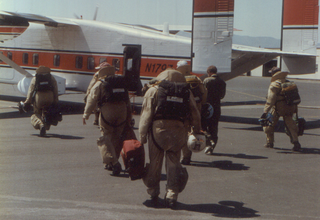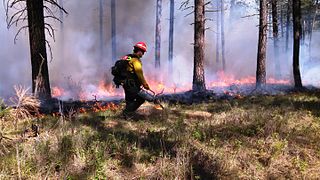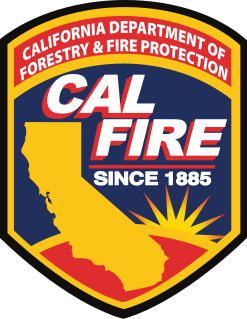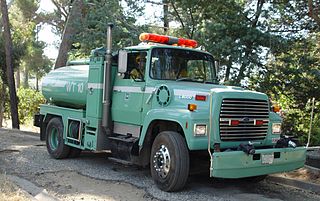
The United States Forest Service (USFS) is an agency of the U.S. Department of Agriculture that administers the nation's 154 national forests and 20 national grasslands. The Forest Service manages 193 million acres (780,000 km2) of land. Major divisions of the agency include the Chief's Office, National Forest System, State and Private Forestry, Business Operations, and Research and Development. The agency manages about 25% of federal lands and is the only major national land management agency not part of the U.S. Department of the Interior, which manages the National Park Service, the U.S. Fish and Wildlife Service, and the Bureau of Land Management.

Smokejumpers are specially trained wildland firefighters who provide an initial attack response on remote wildland fires. They are inserted at the site of the fire by parachute.

A controlled or prescribed burn, also known as hazard reduction burning, backfire, swailing, or a burn-off, is a fire set intentionally for purposes of forest management, farming, prairie restoration or greenhouse gas abatement. A controlled burn may also refer to the intentional burning of slash and fuels through burn piles. Fire is a natural part of both forest and grassland ecology and controlled fire can be a tool for foresters.
This glossary of wildfire terms is a list of definitions of terms and concepts relevant to wildfires and wildland firefighting. Except where noted, terms have largely been sourced from a 1998 Fireline Handbook transcribed for a Conflict 21 counter-terrorism studies website by the Air National Guard.

The California Department of Forestry and Fire Protection is a fire department of the California Natural Resources Agency in California, United States. It is responsible for fire protection in various areas under state responsibility totaling 31 million acres, as well as the administration of the state's private and public forests. In addition, the department provides varied emergency services in 36 of the state's 58 counties via contracts with local governments. The department's director is Thom Porter, who was appointed by Governor of California Gavin Newsom.

In the United States, a hotshot crew, formally known as an interagency hotshot crew, is a handcrew of 20-22 wildland firefighters which responds to large, high-priority fires across the country and are assigned to work the most challenging parts of the fire. They have specific qualifications to provide leadership for initial-attack and extended-attack on wildland fires, and are trained and equipped to work autonomously in remote areas for extended periods of time with little or no logistical support. Hotshot crews are the most highly trained, skilled, and experienced type of handcrews. Hotshot crews are organized by agencies such as the United States Forest Service, National Park Service, Bureau of Indian Affairs, Bureau of Land Management, and state and county agencies; the National Interagency Fire Center coordinates hotshot crews on the federal level.

Wildfire suppression is a range of firefighting tactics used to suppress wildfires. Firefighting efforts in wild land areas require different techniques, equipment, and training from the more familiar structure fire fighting found in populated areas. Working in conjunction with specially designed aerial firefighting aircraft, these wildfire-trained crews suppress flames, construct fire lines, and extinguish flames and areas of heat to protect resources and natural wilderness. Wildfire suppression also addresses the issues of the wildland-urban interface, where populated areas border with wild land areas.

A wildland fire tender is a specialized vehicle capable of bringing water, foam, or dry chemicals to fire trucks in the field that are engaged on the fireline. These vehicles are specifically designed for fire fighting often with four-wheel drive, rugged suspension and high wheel clearance for mountainous dirt road conditions. According to the National Fire Protection Association, if the apparatus will be used primarily for outdoor and wildland responses, then it is to be considered a wildland fire apparatus and must conform to NFPA 1906.

The National Wildfire Coordinating Group (NWCG) was formed in the United States as a result of the aftermath of a major wildfire season in 1970.
The Work Capacity Test (WCT), known informally as the pack test, is a U.S. Forest Service physical test for wildland firefighters. The pack test is intentionally stressful as it tests the capacity of muscular strength and aerobic endurance of the firefighter. There are three tests known as arduous, moderate, and light. The pack test may be given as part of the S-130/S-190 basic wildland firefighter course.

The Yellowstone fires of 1988 collectively formed the largest wildfire in the recorded history of Yellowstone National Park in the United States. Starting as many smaller individual fires, the flames quickly spread out of control due to drought conditions and increasing winds, combining into one large conflagration which burned for several months. The fires almost destroyed two major visitor destinations and, on September 8, 1988, the entire park closed to all non-emergency personnel for the first time in its history. Only the arrival of cool and moist weather in the late autumn brought the fires to an end. A total of 793,880 acres (3,213 km2), or 36 percent of the park, was affected by the wildfires.
The International Association of Wildland Fire (IAWF), a non-profit organization, is professional association of the wildland fire community. IAWF is an independent organization, not affiliated with any private or public agencies. It purpose is to offer a common and neutral ground for the discussion of important and often controversial wildland fire issues. The organization has a 15-member board of directors. It aims to include members in the areas of wildland fire management, research, suppression, and policy.
Helitack crews are teams of wildland firefighters who are transported by helicopter to wildfires. Helicopters provide rapid transport, enabling helitack crews to quickly respond and assess a wildfire situation. Helitack crews may land near a wildfire or, if equipped and trained, rappel from a hovering helicopter. Once on the ground, crews build firelines using hand tools, chainsaws, and other firefighting tools. They often remain overnight in remote locations. After they have completed their assignment, crew members may pack up to 120 pounds of equipment over difficult terrain to reach a pick-up point. Rappellers often prepare helispots that provide better access to a fire. Helicopter crew members may also perform other duties such as tree falling, firing operations, and managing helibases.
Wildfire suppression in the United States has had a long and varied history. For most of the 20th century, any form of wildland fire, whether it was naturally caused or otherwise, was quickly suppressed for fear of uncontrollable and destructive conflagrations such as the Peshtigo Fire in 1871 and the Great Fire of 1910. In the 1960s, policies governing wildfire suppression changed due to ecological studies that recognized fire as a natural process necessary for new growth. Today, policies advocating complete fire suppression have been exchanged for those who encourage wildland fire use, or the allowing of fire to act as a tool, such as the case with controlled burns.
Wildfire suppression equipment and personnel is part of the science of fire fighting focusing on the use of specialized equipment, training and tactics to effectively control, surround and eventually extinguish a natural cover fire. There are several specially designed tools that through their function and user training, perform specialized tasks that are specific to natural cover firefighting. This is used together in conjunction with the general understanding of the behavior of fire to form a viable plan of attack.

The Nebraska Forest Service is the state forestry agency for the state of Nebraska. The Nebraska Forest Service serves the citizens on Nebraska by operating with the mission to provide services and education to the people of Nebraska for the protection, utilization and enhancement of the State's tree, forest and other natural resources. Headquartered in Lincoln, Nebraska, the Nebraska Forest Service is embedded within the Institution of Agriculture and Natural Resources at the University of Nebraska-Lincoln.

Wildfires are outdoor fires that occur in the wilderness or other vast spaces. Other common names associated with wildfires are brushfire and forest fire. Since wildfires can occur anywhere on the planet, except for Antarctica, they pose a threat to civilizations and wildlife alike. In terms of emergency management, wildfires can be particularly devastating. Given their ability to destroy large areas of entire ecosystems, there must be a contingency plan in effect to be as prepared as possible in case of a wildfire and to be adequately prepared to handle the aftermath of one as well.

The New Jersey Forest Fire Service (NJFFS) is an agency within the New Jersey Department of Environmental Protection. Founded in 1906 with a focus on wildland fire suppression and fire protection, the Forest Fire Service is the largest firefighting department within the state of New Jersey in the United States with 85 full-time professional firefighting personnel, and approximately 2,000 trained part-time on-call wildland firefighters throughout the state. Its mission is to protect "life and property, as well as the state's natural resources, from wildfire".

Wildfires can happen in many places in the United States, especially during droughts, but are most common in Western United States and Florida. They may be triggered naturally, most commonly by lightning, or by human activity like unextinguished smoking materials, faulty electrical equipment, overheating automobiles, or arson. Fire management policy favored aggressive wildfire suppression starting in the early 20th century. In the 21st century, higher temperature and droughts driven by global warming have become more of a concern, and there has been increased advocacy for controlled burns and other measures to prevent fuel from accumulating in wild areas that can create more intense, larger, and difficult to control fires. Firefighters are generally employed by governments, including municipal and county fire departments, regional mutual aid organizations, and state agencies like the California Department of Forestry and Fire Protection and the New Jersey Forest Fire Service. Wildfire response is coordinated at the federal level by the National Interagency Fire Center, with the participation of the U.S. National Weather Service, and various agencies of the Departments of the Interior, Agriculture, Homeland Security, and Commerce. Fire squadrons of the United States Army are also sometimes called to large fires.

The 1998 Florida wildfires, sometimes referred to as the Florida Firestorm, was a wildfire event involving several thousand separate woodland and mixed urban-rural wildfires which wrought severe damage during the summer months of 1998. Wildfires sparked mainly by lightning threatened to converge into single, vast blazes, crossed natural firebreaks such as rivers and interstate highways, and demanded an unprecedented suppression response of firefighting resources from across the country. Regular activities such as Fourth of July celebrations, sporting events, tourism, and daily life were profoundly interrupted for millions of residents and visitors in the northeastern part of the state.